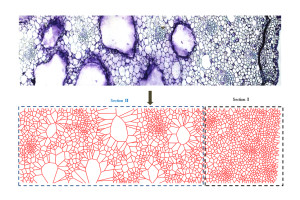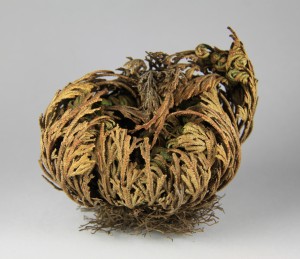 Finite-edge Centroidal Voronoi Tessellation Generating a Realistic Model of Philodendron Melinonii Tissue |
Description
In collaboration with Professors A. Rey from Chemical Engineering and T. Western from Biology, this project uses multiscale mechanical testing and computational modelling to investigate the effect of plant tissue, cell arrangements, composite wall composition and geometrical changes on the spatial and temporal features of water-regulated folding patterns in resurrection plants. Our biological engineering study is based on four resurrection plants that have been characterized to show folding at the plant, leaf and cellular level. Multiscale folding occurs through mechanisms triggered across the whole spectrum of length scale. The overall aim is to extract principles of actuation in response to external stimuli for use in proof-of-concept actuating devices that respond to water. Particular attention is devoted to the study of the structural and material changes as a response to water content, with an emphasis on the role played by cellular microarchitecture.
Relevant Publications
- Rafsanjani, A., Brule, V., Western, T.L., Pasini, D., Hydro-Responsive Curling of the Resurrection Plant Selaginella lepidophylla, Scienific Reports, Vol. 5, 8064, 2015. link to PDF
- Faisal, T.R., Rey, A., Pasini, D., A Multiscale Mechanical Model for Plant Tissue Stiffness, Multiscale Simulations in Soft Matters (special issue of Polymers), Vol. 5 (2), pp. 730-750, 2013. link to PDF
- Murugesan, Y., Pasini, D., and Rey, A.D., Defect Textures in Polygonal Arrangements of Cylindrical Inclusions in Cholesteric Liquid Crystal Matrices, Soft Matter, Vol. 9, (4), pp. 1054-1065, 2013. link to PDF
- Faisal, T.R., Hristozov, N., Rey, A., Western, T., Pasini, D., Experimental determination of Philodendron melinonii and Arabidopsis thaliana tissue microstructure and geometric modeling via Finite Edge Centroidal Voronoi Tessellation, Physical Review E , 86(3-1):031921, 2012. link to PDF
- Y. K. Murugesan, D. Pasini, and A. D. Rey, Microfibril Organization Modes in Plant Cell Walls of Variable Curvature: A Model System for Two Dimensional Anisotropic Soft Matter, Soft Matter, 7 (15), 7078 – 7093, 2011. link to PDF
- Faisal, T.R., Khalil Abad, E.M., Pasini, D., The Impact of Tissue Morphology, Cross-Section and Turgor Pressure on the Mechanical Properties of the Leaf Petiole in Plants, International Journal of Bionic Engineering, Vol (7), pp. 11-23, 2010. link to PDF
